MVP Development For Startups : Everything You Need to Know
Date
Aug 07, 25
Reading Time
20 Minutes
Category
Low-Code/No-Code Development
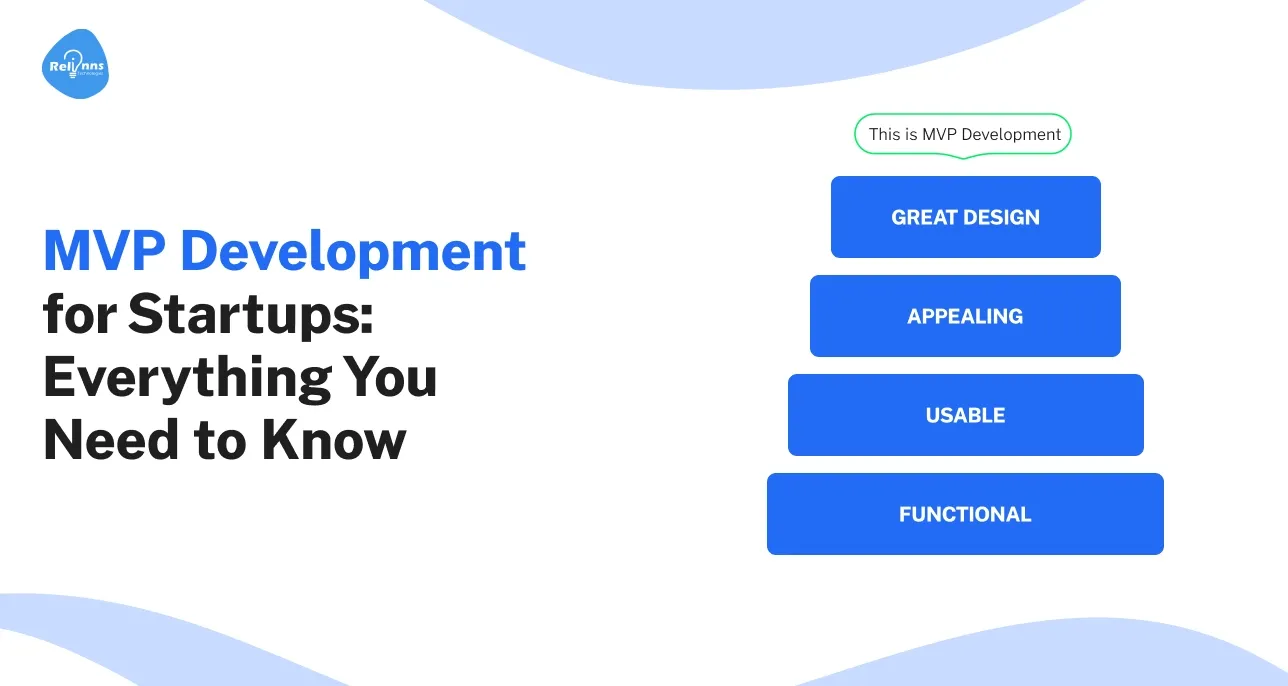
MVP stands for Minimum Viable Product. It’s the simplest functional version of a product that can still deliver value to early users.
Launching a new product is exciting, but it’s also risky. Instead of spending months building every possible feature, startups often begin with a Minimum Viable Product (MVP) a simplified version that solves the core problem for early users.
The purpose of an MVP isn’t perfection, but validation. By releasing a functional prototype quickly, startups can test assumptions, gather real feedback, and refine their ideas before investing heavily in full development. This rapid learning cycle reduces wasted effort.
Rooted in the Lean Startup “build-measure-learn” approach, MVP development helps founders confirm market demand. With around 40% of startups failing due to a lack of product–market fit, starting small and iterating fast is often the smartest path to long-term success.
Why MVP matters for startups?

MVP development for startups matters because it fundamentally reduces risk. For a cash- and time-strapped startup team, building an MVP offers multiple benefits over developing a full-blown product from day one.
- MVP helps validate your idea early by testing if users find value in your solution.
- You build only essential features, saving time and money while minimizing product development waste.
- 64% of software features are unused MVP avoids that by focusing on essential functionality.
- Fast MVP launch lets startups learn, earn, and improve before competitors hit the market.
- No-code MVPs launch 78% faster than traditional builds often in just 2 to 4 weeks.
- Early MVP traction shows real-world demand and helps attract investors through measurable user engagement.
- MVP proves your startup’s potential with data-driven evidence, not assumptions or theoretical market guesses.
To illustrate the impact, let’s compare building an MVP versus a full product.
Aspect | MVP Development (Lean Approach) | Full Product Development (All-In Approach) |
| Scope (Features) | Only core must-have features to solve the primary problem; no frills. | Complete feature set with all bells and whistles fully built out. |
| Time to Market | Short – often a few weeks to a couple of months to launch an MVP. | Long – can take many months or even years before release. |
| Cost | Low budget – build only essentials, thereby conserving cash and resources. | High budget – significantly larger investment to develop and polish everything. |
| User Feedback | Gather early feedback from real users and iterate rapidly (build-measure-learn cycle). | Little to no real user feedback until after heavy investment (feedback comes late in the process). |
| Risk | Lower risk – you test viability before scaling; can pivot with minimal losses if needed. | Higher risk – all-or-nothing bet that the fully built product will find market fit, which may fail. |
As the table shows, MVP development for startups offers a lower-risk, higher-learning path.
It’s about doing the minimum to verify that you’re on the right track, then expanding. A startup’s resources are limited, so it’s crucial to spend them wisely.
Even hugely successful companies started small Instagram began as a bare-bones photo-sharing app (originally called “Burbn”), and Dropbox tested interest with just a simple demo video.
MVPs that prove their worth can be scaled up into the next big thing, while those that fail save you from bigger mistakes down the road.
What are the different types of MVPs every startup should know before launching?
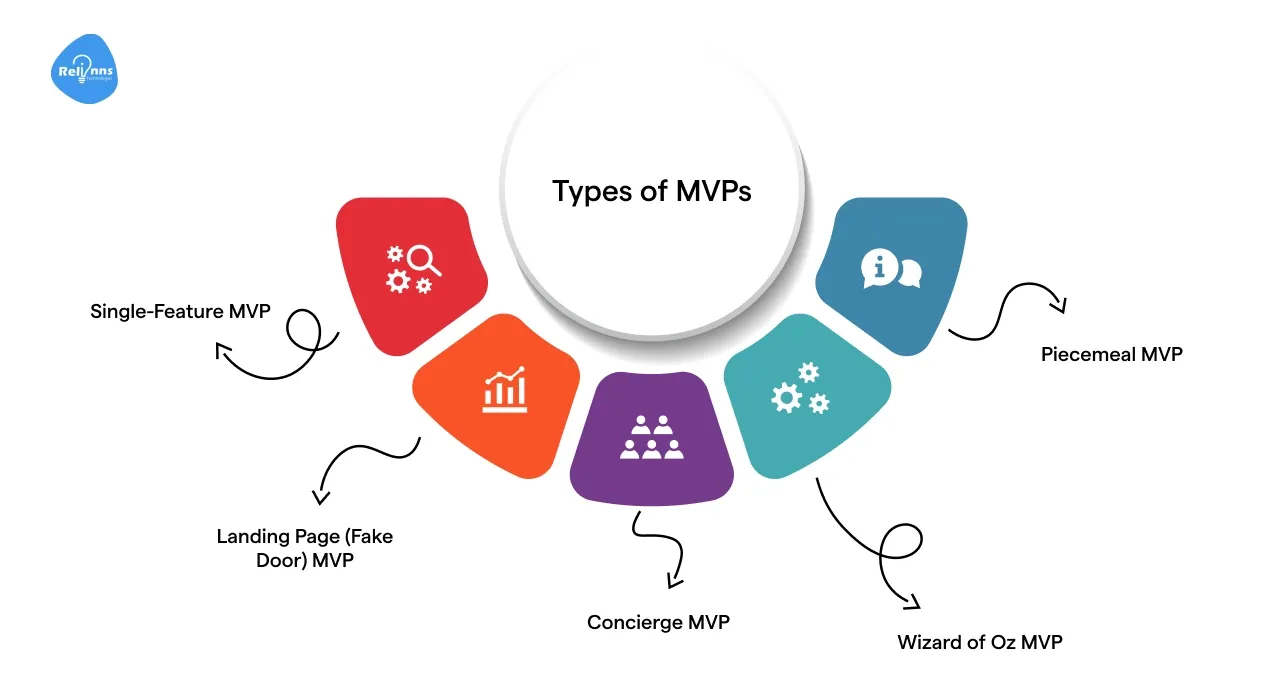
Not all MVPs look alike. There are different approaches to MVP development for startups, ranging from very low-tech experiments to functional early versions of an app.
The type of MVP you choose depends on your product and what you need to learn. Here are some common types of MVPs.
Single-feature MVP
- Focuses on one core feature to validate user demand quickly.
- Simplifies development with fewer features, reducing time and cost
- Helps test core value proposition without extra distractions or complexity.
- Easier to iterate based on early user behavior and feedback.
- Ideal for fast MVP app development with limited resources available.
Landing page (fake door) MVP
- Tests real user interest before building the actual product backend.
- Involves creating a simple landing page with core messaging.
- Includes a CTA like “Sign Up” to gauge demand.
- Collects emails or clicks as proof of user intent.
- Ideal for validating concepts quickly without writing product code.
Concierge MVP
- You manually deliver services instead of building automated product features.
- Mimics app behavior through direct human interaction with early users.
- Helps validate value before investing in tech development or automation.
- Offers personalized experience while testing with minimal coding effort.
- Ideal for service-based MVP app development in early validation stages.
Wizard of Oz MVP
- Users believe the product is automated, but it's manually operated.
- Simulates real software outputs through behind-the-scenes human effort.
- Tests user experience without building full product infrastructure upfront.
- Ideal for validating functionality before investing in backend development.
- Helps gauge demand while maintaining illusion of working product.
Piecemeal MVP
- Combines existing tools to simulate full product functionality manually.
- Avoids custom coding by leveraging off-the-shelf solutions and integrations.
- Ideal for quickly testing ideas without building entire system.
- Uses simple scripts or manual workflows to connect various components.
- Great for MVP app development with limited budget or resources.
Each of these MVP types has the same goal: gauge interest and collect learnings with minimal development effort.
Whether it’s a fully coded single-feature app or a manual Wizard of Oz setup, an MVP should answer the key question: “Do we solve a real problem that users care about?”
Choose the MVP style that best fits what you need to learn. The key is to keep it simple, quick, and laser-focused on your core assumption.
What are the 8 essential steps for MVP development in startup success?
Building an MVP is a step-by-step journey. By following a structured process, you ensure that you cover all the bases from idea to launch. Here are the key steps for successful MVP development for startups.
Research the Market and Define the Problem
- Identify a real customer problem your product aims to solve.
- Conduct interviews and surveys to gain a deep understanding of user pain points.
- Study competitors to uncover market gaps and unmet user needs.
- Avoid building solutions without validating the actual problem first.
- Ground MVP development for startups in real-world research and user validation.
Define the Core Value Proposition
- Define the single most compelling benefit your product will offer.
- Focus on solving one key problem for your target users.
- Craft a clear, concise value proposition statement for clarity.
- Avoid thinking about extras, stick to the core user value.
- Let your MVP revolve around this primary value: delivery only.
List Out Features and Prioritize Ruthlessly
- List all possible features your MVP app could include initially.
- Use the MoSCoW method to separate essential from optional features.
- Focus only on must-haves that deliver core product value.
- Cut non-essential features to reduce development time and cost.
- Avoid overbuilding: 64% of product features often go unused.
Sketch the User Journey and Create Wireframes
- Visualize the core user journey from entry to value delivery point.
- Sketch key screens to understand the essential interface and flow.
- Use basic mockups or hand-drawn wireframes to plan the layout.
- Ensure the user experience is intuitive, focused on the main functionality.
- Simplify before moving into actual MVP development for startups.
Choose the Tech Stack & Approach
- Choose coding, frameworks, or no-code based on team skills.
- No-code tools like Joget or Adalo enable faster MVP development for startups.
- Use frameworks like Rails, Django, or React Native for flexibility.
- Prioritize speed, simplicity, and adaptability over perfect architecture early.
- Low-code tools expected to power 70% of apps by 2025.
Develop the MVP
- Begin developing only the must-have features from your plan.
- Avoid feature creep by sticking strictly to the defined MVP scope.
- Focus on usability and reliability over perfect design or polish.
- Use templates, manual workarounds, or hard-coded shortcuts to save time.
- Document assumptions to validate later through user testing and feedback.
Test Internally and Refine
- Test the MVP internally to catch bugs and user issues.
- Simulate real usage scenarios with team or close contacts.
- Focus on verifying core user flow from start to finish.
- Fix only critical blockers, not minor cosmetic imperfections yet.
- Launch imperfectly-speed matters more than polish at the MVP stage.
Launch to Early Adopters
- Identify early adopters likely to benefit from your MVP.
- Launch product quietly to a controlled audience, not general public
- Use beta groups, forums, or waitlists to onboard testers.
- Communicate clearly that it’s an early version needing feedback
- Collect insights from real usage to guide future improvements.
Each step ensures that your MVP stays aligned with solving a real problem and remains as lean as possible. Building an MVP is an iterative process – even at launch, you should be prepared to refine and update.
In the next sections, we’ll discuss how to prioritize features as you iterate, choose the right technology stack, and validate the MVP post-launch.
How to prioritize features in MVP development for startups?
Prioritizing features is one of the most important steps in MVP development for startups. Founders often overestimate what users need at launch, leading to bloated MVPs and delayed timelines.
Startups should focus on building only what is necessary to deliver the product’s core value. This approach reduces cost, simplifies testing, and allows better iteration. Below are key strategies to prioritize features effectively during MVP app development.
1. Start with the core user flow
Begin by identifying the primary job your user needs to accomplish. Map the simplest end-to-end user journey that delivers value. This helps isolate which features support the main flow and which do not.
Any feature not directly enabling the core experience should be excluded from the MVP. This clarity ensures you're solving a real problem in the most direct way possible.
Key factors to consider
- Define the main task your user wants to complete effectively.
- Map core steps from the entry point to the final user action.
- Exclude unrelated features that do not support the central experience.
- Ensure the MVP functions around a focused, goal-oriented path.
- Avoid distractions by limiting the user journey to core utility only.
2. Apply a feature prioritization framework
Frameworks help categorize which features matter most and which can wait. Two standard techniques include the MoSCoW Method and the Impact vs Effort Matrix.
These methods offer structured prioritization based on value, complexity, and business goals. The goal is to build only what is essential for validating your product idea.
Key factors to consider
- Use MoSCoW: Must-Have, Should-Have, Could-Have, Won’t Have labels.
- Focus only on must-haves for the MVP app development scope.
- Plot features on an impact versus effort prioritization grid.
- Discard features that are low impact or overly complex.
- Ask if the MVP succeeds without a given feature.
3. Leverage early feedback and user research
Feature prioritization is not purely hypothetical. Real user data, research insights, or beta testing results can guide decisions. Many features assumed to be critical may not be as valuable to early adopters.
MVP development for startups benefits when honest feedback overrides the founder's assumptions. Data-driven prioritization ensures better market alignment and resource efficiency.
Key factors to consider
- Collect insights from early surveys, interviews, or usability tests.
- Identify what features users consider most valuable or urgent.
- Avoid overestimating the importance of features with unclear user demand.
- Use data to support every prioritization decision you make.
- Focus on delivering features that align with proven user interests.
4. Evaluate technical complexity vs. strategic value
Even if two features are equally important, their implementation complexity may differ. Choose the one that delivers value faster. In some cases, simulate complex functionality manually during the MVP stage.
A streamlined MVP allows faster release, feedback, and potential pivoting. Save complex automation or integrations for later phases.
Key factors to consider
- Assess the technical effort required for each feature implementation.
- Prioritize features that are easier to build and maintain.
- Delay complex features if they slow MVP development for startups unnecessarily.
- Use manual or simple alternatives during the early release.
- Balance value delivery with time, cost, and team bandwidth.
5. Document and align on the final feature scope
Listing what will and will not be included is essential. This avoids confusion, prevents scope creep, and aligns expectations across the team, investors, and stakeholders.
MVP app development runs smoothly when everyone understands the defined boundaries. List out exclusions just as clearly as inclusions.
Key factors to consider
- Create a detailed list of features in scope for the MVP.
- Maintain a second list for deferred post-MVP feature sets.
- Share the scope documentation with your team and stakeholders.
- Lock the MVP scope before beginning development or design work.
- Update the list only with validated post-launch feedback data.
6. Stay flexible after launch
Feature prioritization is not a one-time exercise. Once your MVP is live, usage data may uncover new must-haves or validate earlier assumptions. Update your roadmap accordingly.
Iterating based on real-world evidence leads to stronger product-market fit and sustainable growth.
Key factors to consider
- Use post-launch insights to reprioritize and refine features
- Add or remove features based on live user behavior patterns.
- Continue to evaluate impact versus effort at every phase.
- Avoid adding features unless they meet validated user needs.
- Let feedback from MVP 1.0 shape the version 2.0 roadmap.
MVP tech stack choices for startups
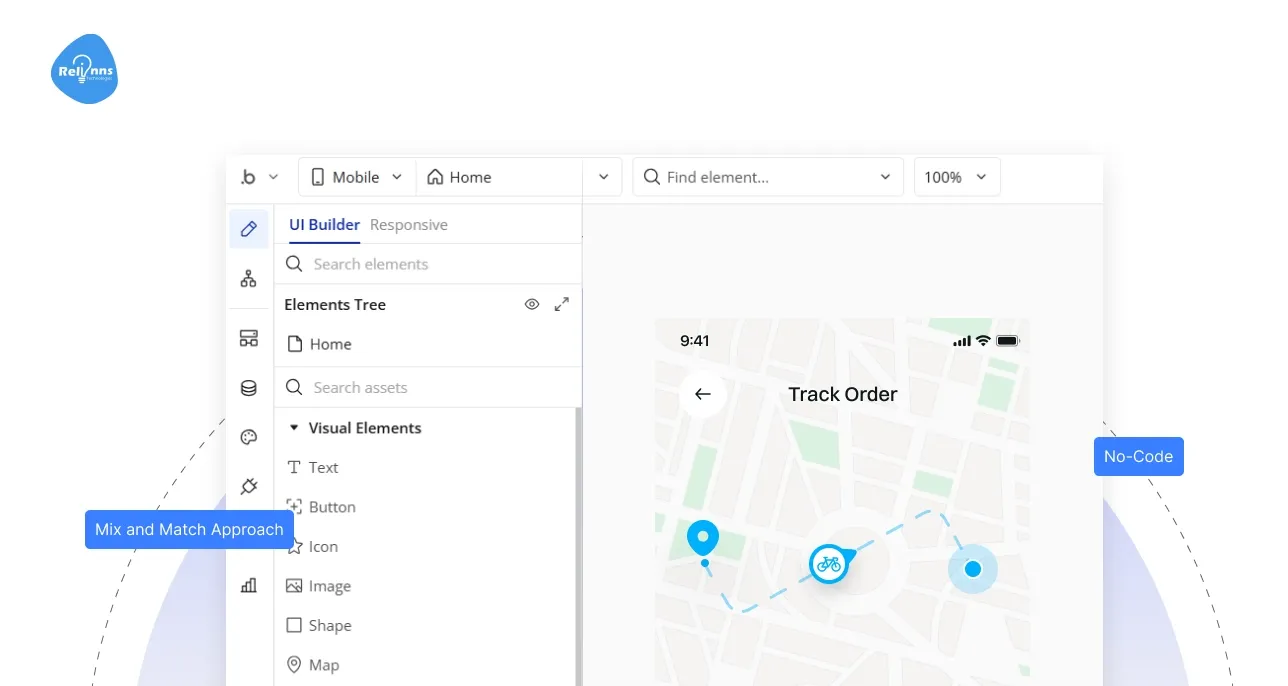
Choosing the right technology stack is a pivotal decision in MVP development for startups. The tech stack will influence how fast you can build, how easily you can change course, and how well the MVP can scale later.
Here are some considerations and options when deciding how to build your MVP.
A. No-code and low-code platforms
For non-technical founders or time-sensitive MVP app development, no-code platforms offer a powerful option. Tools like Bubble, Adalo, and Webflow allow you to create apps through visual builders. These platforms are ideal for early testing, drastically cutting development cost and launch time.
No-code MVPs are best when customization needs are low and speed is essential. Many startups validate ideas with no-code tools, then rebuild with traditional code after proving traction.
Key factors to consider
- Build apps visually without needing coding or engineering support.
- Launch faster and cheaper using drag-and-drop UI logic tools.
- Ideal for solo founders who need a quick proof of concept.
- Limits in customization and scale may require future rebuilding.
- Popular for pre-seed MVP development across startup ecosystems globally.
For startups based in the United States, browse this comprehensive list of low-code/no-code MVP development agencies in the USA.
B. Traditional coding (custom development)
If your team includes developers or the MVP requires custom logic, traditional coding is often best. Full-stack frameworks allow precise control, scalability, and better long-term flexibility. Languages like JavaScript, Python, and PHP are commonly used in early-stage MVP builds.
Using code also enables integration with advanced libraries, APIs, or custom backend logic. This approach suits founders prioritizing tech depth or product uniqueness in MVP app development.
Key factors to consider
- Provides full control over backend, frontend, and database structure.
- Supports advanced features that are unavailable through no-code platforms.
- Choose familiar stacks: Django, Laravel, React, Node.js, or Flutter.
- Use BaaS tools like Firebase to speed up backend setup.
- Ideal for MVPs with technical depth or advanced scalability requirements.
C. Mix-and-match (hybrid stack)
Many modern MVPs combine no-code and code for speed and flexibility. You might code the main app but use Webflow for the site. Or use Airtable and Zapier on the backend while React powers the front-end.
This approach enables cost-efficiency without sacrificing necessary customization. It’s increasingly common in MVP development for startups working with limited teams or outsourcing partners.
Key factors to consider
- Combine custom development with automation or low-code solutions smartly.
- Use prebuilt services for payments, forms, or admin dashboards.
- Great for reducing scope and cost in the MVP early phase.
- Supports rapid deployment without sacrificing long-term flexibility entirely.
- Ideal for lean teams needing quick results without a full-code stack.
How can you validate your MVP development for startups the right way?
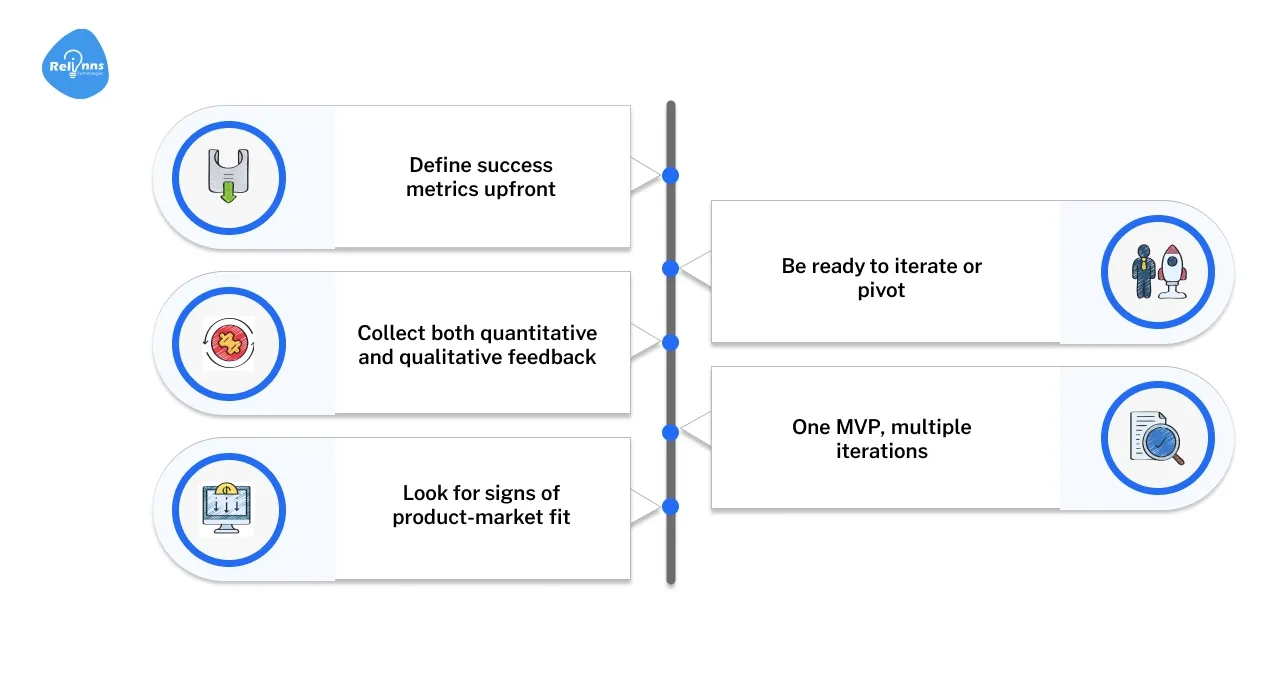
Launching your MVP is not the end; validation is what proves whether your product idea works in the real world. You need to test your assumptions, analyze key metrics, and gather user feedback to determine if the MVP solves a real problem.
This is the point where you move from building to learning. Proper validation gives you clarity on whether to iterate, pivot, or scale.
Validation is the process of checking whether your core idea resonates with users and delivers real value.
Key factors to consider
- Define specific success metrics before collecting feedback or tracking usage.
- Use both analytics tools and user interviews to gain insight.
- Look for signals like retention, referrals, or product misuse creatively.
- Be prepared to iterate based on real usage and user sentiment.
- Validation often happens in multiple phases, not a single event.
What common mistakes should startups avoid in MVP development?
Even with the best intentions, many startups fall into predictable traps when building their MVP. These mistakes can lead to wasted time, missed opportunities, or a product that completely misses the mark.
Understanding what to avoid is just as important as knowing what to build. A well-executed MVP avoids over-engineering, listens to users, and focuses on learning, not perfection.
Avoiding these common mistakes ensures your MVP remains lean, targeted, and useful.
Here's what to watch out for.
- Building too many features instead of one focused solution.
- Ignoring user feedback after the MVP is released.
- Delaying launch to chase design or code perfection.
- Choosing the wrong tech stack for speed and flexibility.
- Assuming demand without validating with real user engagement.
When and how to scale your MVP development for startups?
One of the big questions after a successful MVP launch is: When do we scale this thing up? And if it is time, how do we scale effectively without crashing and burning?
Scaling too early or too late can both be problematic, so let’s break this down into when to scale and how to scale for startup MVPs.
A. Knowing when to scale
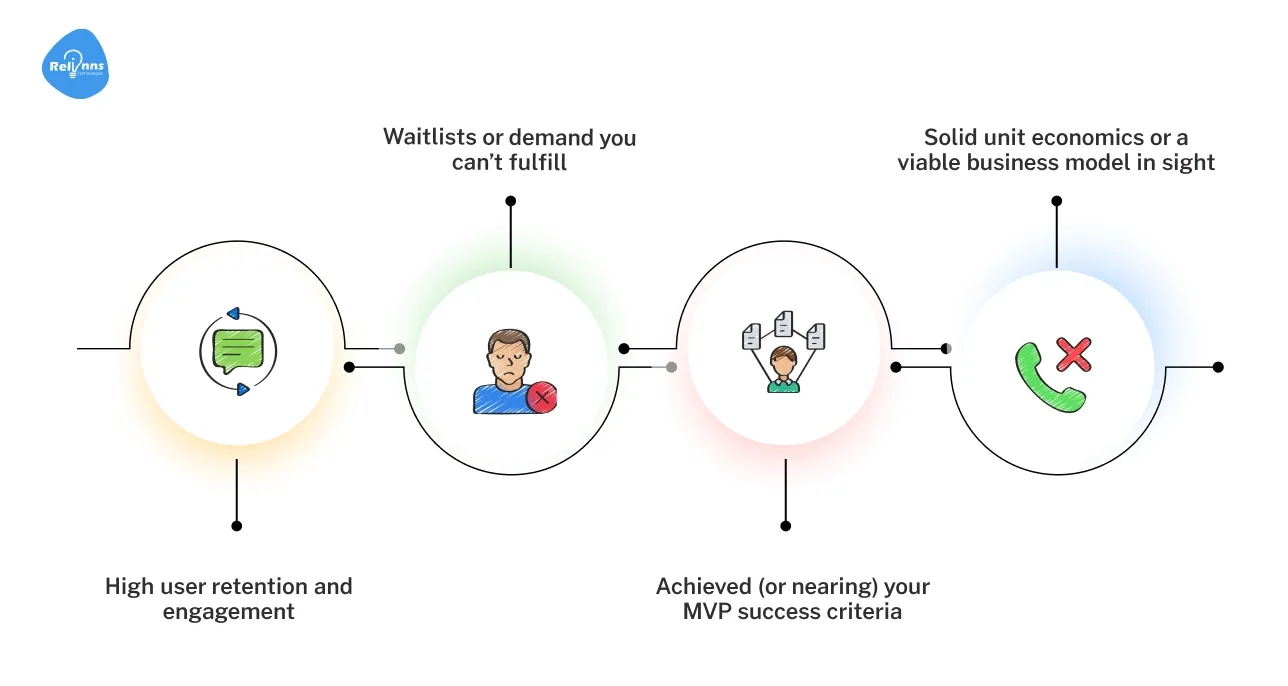
Timing is everything. Scale too soon – before your concept is truly validated or before you’re ready – and you risk collapsing under the weight of premature expansion. Scale too late, and you might miss the market window or let competitors swoop in.
So, how do you know it’s time to graduate from MVP and start growing aggressively?
Look for strong signs of product-market fit and demand. This means your key metrics are trending in the right direction and users are genuinely finding value.
- High user retention and engagement: High retention and organic growth indicate strong product-market fit.
- Waitlists or demand you can’t fulfill: High demand, waitlists, and customer feature requests signal strong market pull and readiness to scale.
- Achieved (or nearing) your MVP success criteria: Meeting or exceeding MVP success metrics means you’re ready to scale operations and grow further.
- Solid unit economics or a viable business model in sight: Revenue-positive MVP with good retention signals financial viability to safely scale.
Importantly, be cautious of premature scaling, which is scaling without these signs.
Studies have found that premature scaling is the leading cause of startup failure – one report showed it afflicted 70% of startups analyzed, and no startup that scaled too early broke the 100k user mark.
In fact, startups that scale properly grow about 20 times faster than those that scale prematurely.
The lesson: don’t rush to scale just because growth is exciting; ensure the foundation is solid. If you scale a wobbly MVP, you’ll just amplify the wobble.
B. How to scale an MVP safely
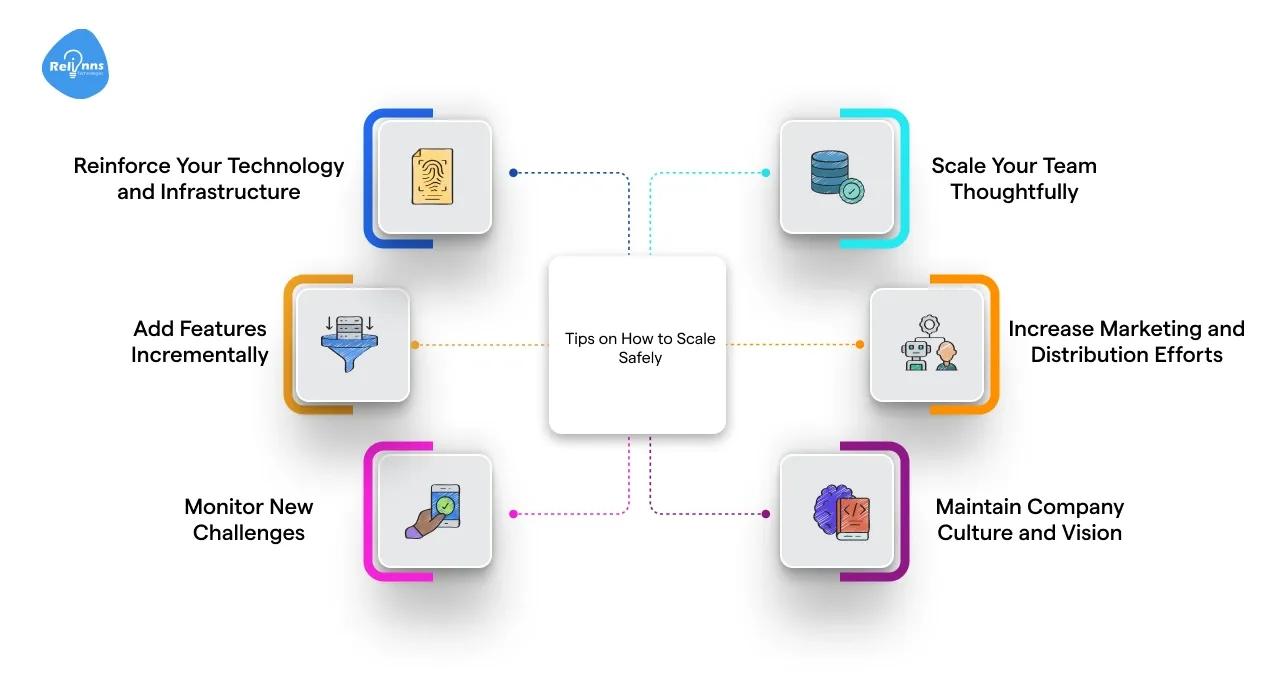
Scaling your MVP is an exciting milestone, but doing it prematurely or haphazardly can be costly. Here’s how to ensure your scale-up is strategic, sustainable, and grounded in user and business reality.
1. Strengthen your infrastructure before traffic grows
Before pushing for growth, make sure your tech can handle it. If your backend or database was built quickly for MVP testing, evaluate its scalability now.
Consider moving from no-code tools to more robust architectures if needed. Use load testing to simulate high traffic and fix any bottlenecks.
Key Practices
- Improve database indexing and queries to handle growing data loads.
- Use CI/CD pipelines to automate deployments, updates, and rollbacks.
- Implement real-time monitoring and automated error alert systems immediately.
- Conduct security audits and meet GDPR and compliance requirements.
- Optimize APIs and infrastructure for both web and mobile scaling.
2. Start hiring for stability, not just speed
You don’t need to double your team overnight, but targeted hiring is often essential. Prioritize roles that reduce bottlenecks (like DevOps or customer support) and increase delivery capacity (like frontend/backend engineers or QA testers).
Avoid hiring to “look like” a growing company.
Hiring Tips
- Create SOPs and workflow guides to onboard new team members efficiently.
- Start with adaptable generalists; add specialists as complexity demands.
- Prioritize candidates who align with your values and mission.
- Bring in freelancers for short-term needs without long-term costs.
- Monitor expenses closely to ensure a sustainable growth pace.
3. Double down on what works
Scale what is already working instead of building new risky features. Study analytics, retention cohorts, and conversion funnels.
Identify power users and core actions that drive results, and then double down on those. Optimize onboarding, checkout, or referral systems before expanding your product scope.
Data-Driven Steps
- Analyze which user cohorts return frequently and why they stay.
- Focus resources on the feature driving the most value or revenue.
- Streamline design for heavily used areas to boost satisfaction.
- Eliminate clutter to reduce confusion and improve performance.
- Tailor experiences based on actions, preferences, and usage data.
4. Expand distribution channels strategically
Once product-market fit is validated, amplify reach through marketing, partnerships, or platform launches. But don’t scale all channels at once.
Focus on 1–2 that show the most promise, then expand as ROI becomes clear. For example, if paid ads work, scale them before launching influencer campaigns.
Channel Strategy Tips
- Implement tools like Mixpanel or GA4 to track conversions.
- Invest in content and backlinks to boost discoverability long-term.
- Experiment with ads slowly to avoid wasting budget upfront.
- Turn satisfied users into promoters with referral incentives.
- Translate and culturally adapt for high-potential regional markets.
5. Invest in customer support and feedback loops
Scaling often leads to a surge in support tickets, questions, and bugs. If support lags, user trust erodes. Build or outsource a help desk.
Add in-product feedback, live chat, or structured surveys to continue learning post-MVP. Scaling doesn’t mean feedback stops – it just becomes continuous.
Support Must-Haves
- Create help articles and FAQs to reduce support load.
- Define response/resolution standards and monitor them closely.
- Use surveys and session replays to understand pain points.
- Align product decisions with recurring customer feedback.
- Prioritize permanent fixes to recurring user complaints.
In summary, scaling safely means knowing what’s working, strengthening it, and ensuring the foundation (tech, team, and process) is ready.
Curious about the best partners for your MVP? Explore this list of top low-code MVP development companies to find the perfect fit for your project.
Final Thoughts on building an MVP development for startups
Building a Minimum Viable Product (MVP) is the most innovative way for startups to validate ideas, conserve resources, and reduce time-to-market.
By focusing on the core value proposition, startups can launch quickly, learn from real users, and iterate confidently without overbuilding.
This guide covers everything you need to know, from defining MVP types and prioritizing features to choosing a tech stack, launching, validating, and scaling successfully. Every step ensures you stay lean, focused, and aligned with market needs.
Why choose Relinns Technologies for MVP development services for startups?
Relinns Technologies helps startups bring ideas to life with powerful low-code and no-code MVP solutions built through Joget development services.
Here’s why startups trust Relinns
- 8+ years of experience: Delivered MVPs across 35+ industries globally
- 50–90% faster delivery: Low-code speeds up development dramatically
- End-to-end MVP support: From ideation to deployment and scaling
- Mobile-first approach: Apps built to work seamlessly across all devices
- Flexible integrations: Connect your MVP to third-party tools and APIs easily
With Relinns, you get a trusted tech partner who understands startup urgency, product-market fit, and lean delivery.
Contact Us for a free consultation or tailored MVP demo.
Frequently Asked Questions (FAQs)
How can I determine if MVP development is the right next step for my startup?
If you’ve validated a real user problem and identified a unique solution, MVP development for startups helps you test the idea with minimal investment and faster time to market.
What are the most cost-effective tools for MVP development for startups?
No-code platforms like Bubble, Glide, and Webflow are great for MVP development for startups needing speed and affordability, while Firebase and React Native support rapid custom development.
How long does MVP development for startups typically take to complete?
MVP development for startups usually takes 4 to 12 weeks, depending on complexity, scope, and team capabilities. The focus is on speed and testing core functionality.
What metrics define success in MVP development for startups?
Key success metrics in MVP development for startups include user retention, conversion rates, activation funnels, and engagement these validate your product’s value in real-world conditions.
Is mobile or web better for MVP development for startups?
For MVP development for startups, choose the platform your audience prefers. Web apps are faster to deploy, but mobile-first MVPs work better if your users rely on smartphones.
Can I pivot my product idea during MVP development for startups?
Yes. MVP development for startups is designed to allow pivots based on real feedback, helping refine product-market fit before investing in full-scale development or marketing.


